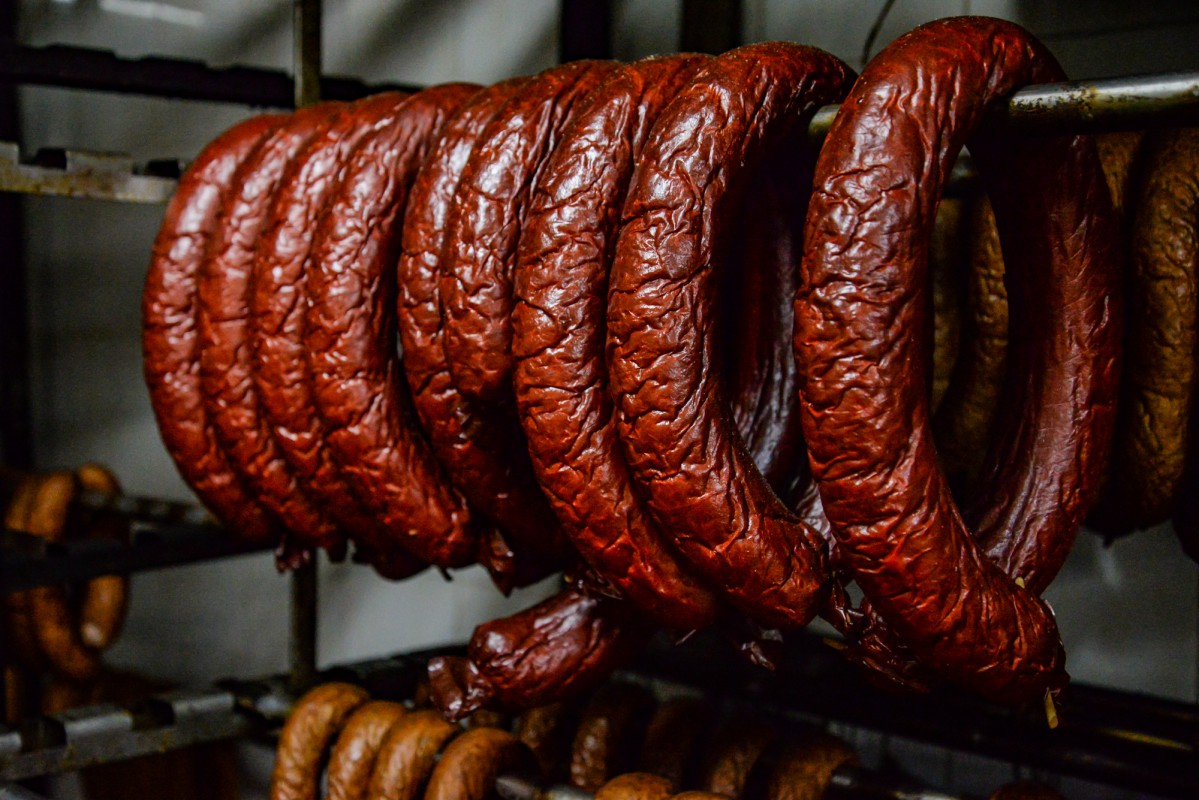Foods of the Traditional Krakow Kitchen: Regional Meats
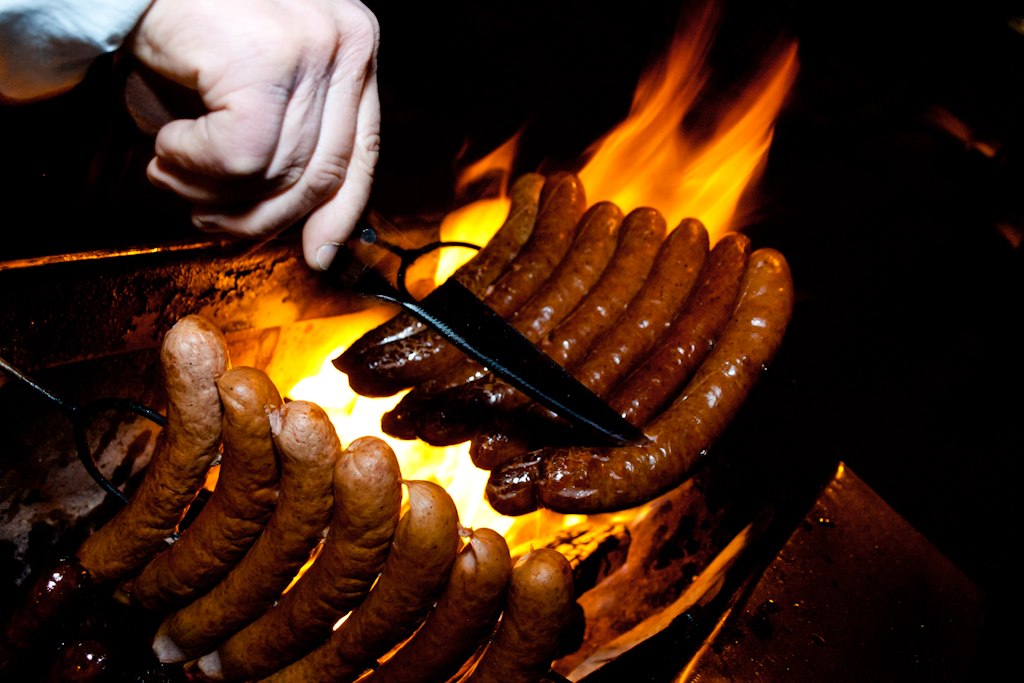
Welcome to our Krakowian kitchen. Pull up a chair at our table as we take you on a journey through the culinary history of this royal city, making stops in surrounding pastoral villages and exotic locations across the world.
Together we will taste the mysterious herbs and spices which transformed the flavours of local palates and the regional delicacies which were the foundation for all the typically Krakowian dishes we still know and love today. Surrounded by rolling green hills, winding rivers, forests filled with mushrooms, high mountains ranges and picturesque farming villages, Krakow is more than rich in diversity of style and ingredients. A fascinating assortment of cuisine, born and reborn in the kitchens of Kazimierz, Debniki, Bronowice, Prądnik and Podgorze, yet brought to life through thousands of years of friendship, family, war, trade and travel.
After devouring this delicious assortment of flavoursome facts, you’ll be hungrier than ever. So, we have also prepared for you a list of where you can try all the treats from our Krakowian kitchen, along with a bonus recipe at the end.
PS: You're so lucky, we have written even more articles in this series! So after you enjoy how funny yet informative this one is, you can read....
Foods of the Traditional Krakow Kitchen: Regional Breads
Foods of the Traditional Krakow Kitchen: Regional Cheeses
Smacznego!
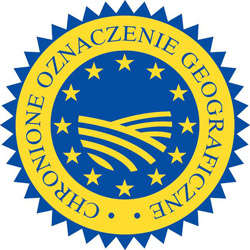
Regional Meats
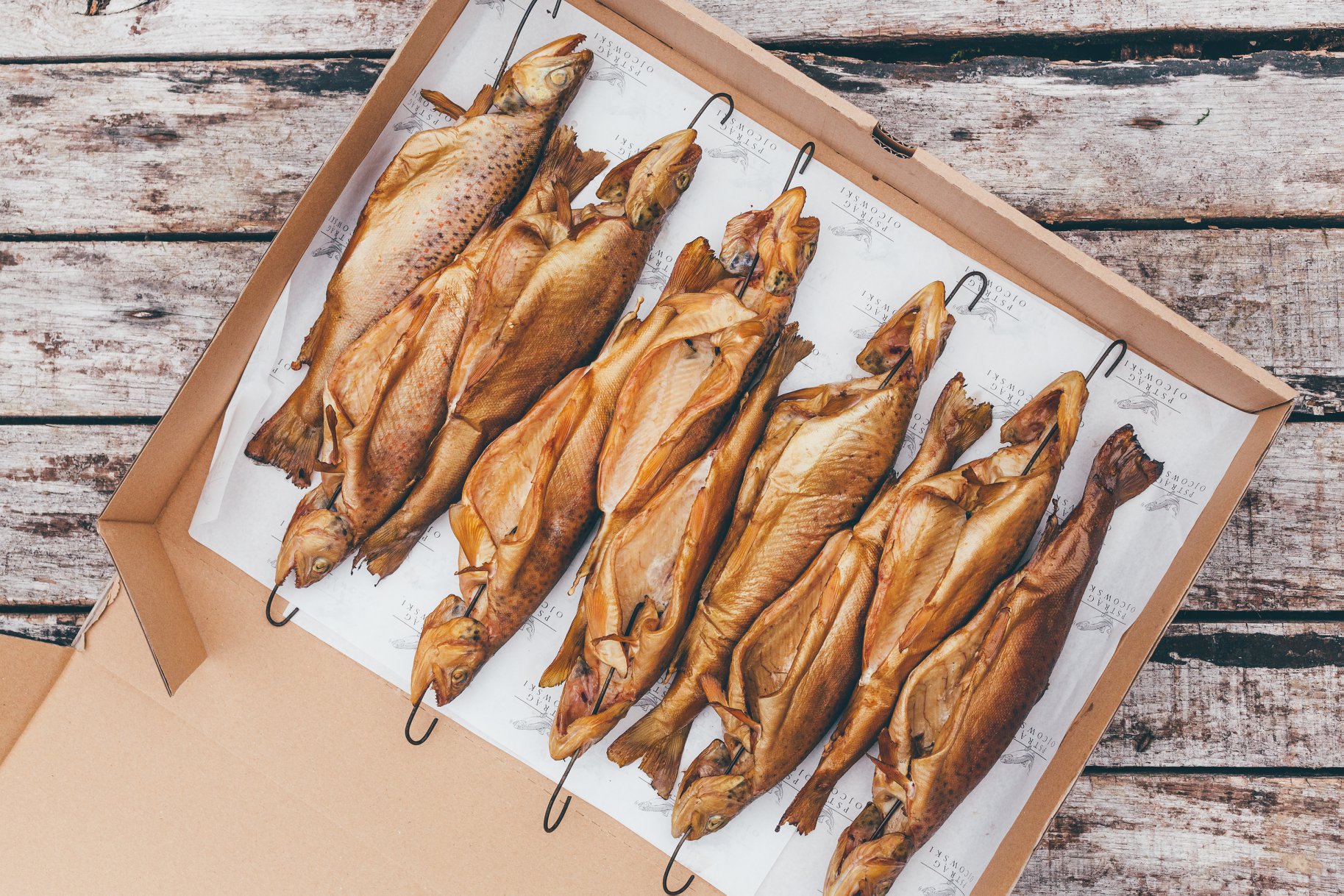
Pstrąg Ojcowski
Arguably the most iconic fish in Poland (perhaps tied with herring), we are once more blessed to have the best just around the river bend! With a maze of interconnected streams, rivers, lakes and creeks winding their way throughout the thirsty fields of the countryside, transporting rafts weighed down by vital goods, splashing beneath the feet of frolicking forest animals, and partitioning otherwise landlocked cities into picturesque riverside retreats - the waterways of Southern Poland have long been its bloodlines. But there’s no need to explain how the plentiful freshwater trout known locally as Pstrąg came to arrive on Krakow’s plates - it’s divinely delicious and right there for the taking. Even in tough times when food was scarce, the trout were about and anyone with a keen rod, a strong net or very fast hands could land themselves a free and very tasty dinner.
The magical wonderland of Ojcow National Park is dominated by Jurassic stone monoliths which litter the forest valleys with limestone fossils. Mysterious ancient castles are carved into the chalky white rock and wildlife abounds. Here, these tenacious trout flourish in rivers as well as in a natural pond farm simply known as ‘Pstrąg Ojcowski’ which has been traditionally tended to by the same family for generations past. Dating back to 1935, Pstrąg Ojcowski was established on the grounds of Princess Ludwika Czartoryska Castle, nestled in the very centre of the National Park amidst breathtaking natural surroundings. Here, the unique microclimate has allowed our special brown trout to develop their own unique flavour and style. Growing strong and healthy in clean and well-oxygenated waters, these pretty fish maintain the true genetic purity of their species.
Pstrąg Ojcowski has become famous throughout the land for its incredible quality, natural production and sublime taste. It’s won many awards and has even been granted the elusive stamp naming it an official ‘Regional Product of Małopolska’.
Where to find it?
- Visit them at home in their beautiful fish ponds and restaurant: Facebook // Official Website
- Try served uniquely by talented chefs in these fantastic Krakowian restaurants: Bottiglieria 1881, Trzy Rybki, Halicka Eatery & Bar
- Or even at Krakow's biggest and best food fair: Najedzenie Fest
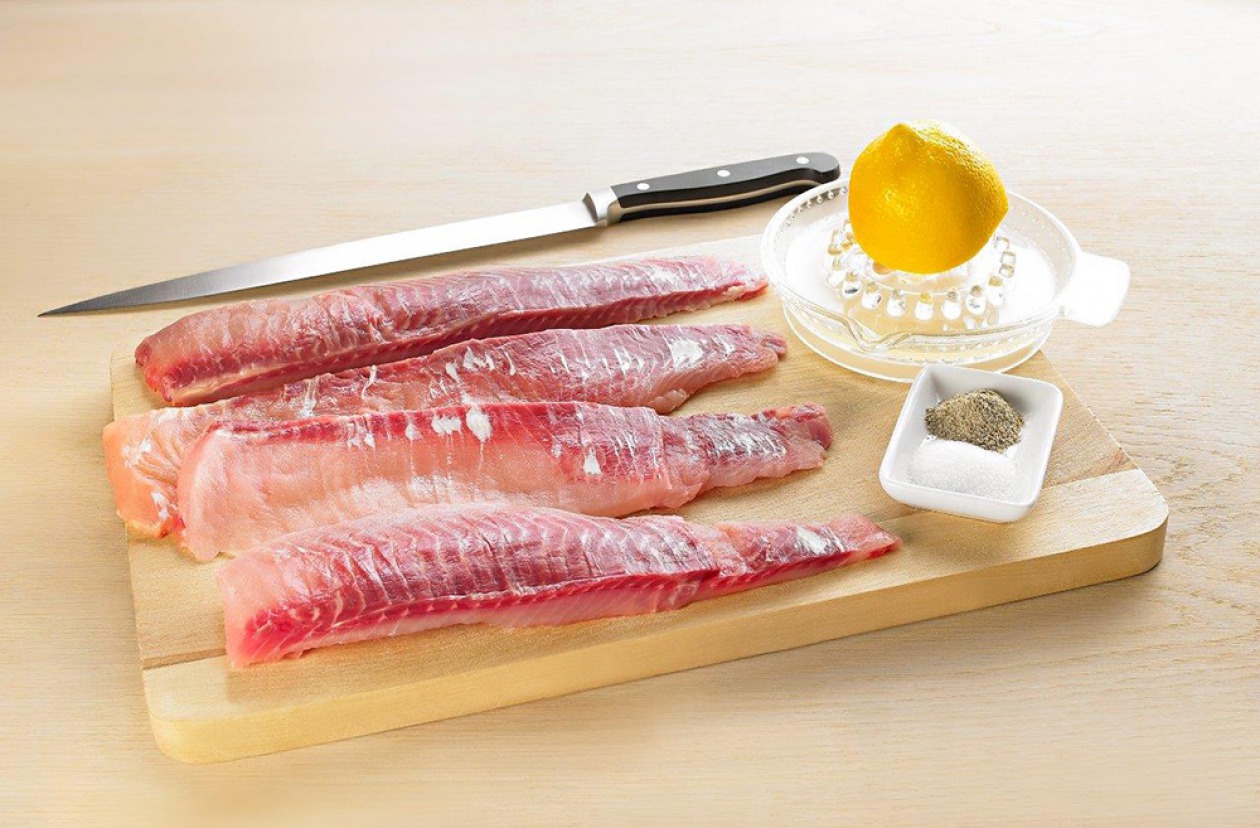
Karp Zatorski
If you’ve ever been to Poland at Christmas, you already know how important carp is to the national cuisine. The centrepiece of the winter holiday meal, this vegemite of fish annually divides the family according to their palatal preferences. However, there’s one kind of carp that's popular all year round, even with those who shun it on Wigilia...
The town of Zator is the capital of Małopolska’s appropriately named ‘Carp Valley’. Within this gorgeous natural area including the Skawa & Wisła rivers, we find hundreds of hectares of historical breeding ponds. It’s so popular with carp lovers and farmers that each year the residents of Zator host an entire festival dedicated to this divisive fish - Zatorskie Dni Karpia (Zator Carp Days).
The name ‘Karp Zatorski’ doesn’t just refer to its place of origin - but to an entirely unique species of carp which evolved over time due to a centuries-old process of breeding and crossbreeding. This was begun in the Middle Ages by the aquaculture obsessed Cistercian Monks who brought the fish all the way from Moravia in their 13th-century suitcases, introducing the carp species to Poland and establishing Zator’s first carp ponds. Legend even has it that these ponds were dug by Tartar prisoners! The practice only grew in popularity amongst locals and nowadays the same families still run the same breeding ponds, passing them along from generation to generation. Apparently, the breeding is mostly done “manually” so we can imagine that it’s a two-for-one kind of situation for parents teaching their children simultaneously how to run the farm and about the birds and the bees.
Although the Karp Zartorski you’ll find on the market today has become a hybrid with secondary heritage in Hungary, Yugoslavia & Israel, it’s still as famous as ever amongst carp connoisseurs. The olive-blue toned swimmers’ winning reputation is born of not only its fascinating history but also its fresh and delicate meat - of which there is plenty with this fast-growing fish quickly reaching up to 1800 grams of high meat mass. The carp develop this voluptuous shape from a diet of local wheat, corn, rye and barley.
In 2011, Karp Zatorski was registered with ‘Protected Designation of Origin’ for the municipalities of Spytkowice, Przeciszów and Zator by the EU.
Interesting facts:
1. Rather ironically, the only listed ‘Notable Person’ on the Wikipedia page for Zator is a man named ‘Roman Rybarski’ whose surname literally translates to ‘fish’.
2. Due to the synonymity of Zator with these Catholic Cyprinidae (scientific term for carp, by the way), people from the area were also commonly referred to as carp! Here, we have re-imagined for you (with great historical accuracy) a conversation down in the local bar:
Mikołaj: “It’s only 3 pm and look how wasted Bołesław is already. He’s outside trying to flirt with that bear again”
Jan: “I’ve got a fair buzz on myself but that guy drinks like a fish”
Mikołaj: “Well, Jan, he is a carp after all!”
*drunken laughter and congratulatory glass clinking ensues
Where to find it?
- Zator: Head over to Zator and you can purchase the carp at Supermarket HANA or the Fisheries Institute itself (addresses here). You can also have it served up on a plate by skilled chefs in local Zator restaurants and cafes such as Revel Pub.
- Go Fishing: in no-kill ponds such as Lowisko Podolsze, who also serve the carp in the traditional manner.
- Taste in Krakow: Restaurant Pod Zlotym Karpiem (Under The Golden Carp) serves a delicious plate of Karp Zatorski with butter, apple sauce and fresh vegetables.
.jpeg?1563533982855)
Gęś Zatorska
Zator must be putting something pretty special in their water because it is home to another regional speciality - Gęś Zatorska, aka Goose from Zator. We’ve already gone over the pure natural scenery which contributes to the development of such beautiful animals, but, like the carp it’s through man's collaborations that this animal came to exist. The famous Zator Goose is a result of the crossbreeding of (among others) the native Pomeranian, Podkarpacka, Garbonosa and Suwałki goose. Under the helm of Professor Helena Bączkowska, these studies were carried out in 1956 by a specialized team of breeders.
From 1961, this genetically designed gaggle were cut off from interaction with any other species of geese as to isolate the DNA, before further selective breeding took place. In 1967, these frankengeese were moved to the Agricultural University in Krakow. The Gęś Zatorska looks more or less like any of its contributing parent species, with white plumage offset by an orange-red beak and legs. However, you can recognise this unique bird from its more widely set legs, its long, slender neck, and wide, convex torso. Of course, as this semi-aquatic poultry was bred specifically for the benefit of man, they grow quite large (from 4 ½ to 6 kg), are composed of extremely high-quality meat with very low-fat content and are capable of producing up to an impressive 47 eggs. A diet of natural fodder such as oats, grass, and potatoes contributes to their delicately delicious, low cholesterol meat.
Although it was registered in 2006 on the ‘List of Traditional Products’ by the Ministry of Agriculture, there is a total population of only 468 Zator Geese living today in Rząska, under the conservatorship of the University of Agriculture in Krakow, making it super rare and therefore the only meat on our list that you are unable to taste for yourself.

Top tip: For the fullest experience and loads more brilliant stories to go with every bite, we recommend a dinner or workshop with Krakowian kitchen queen and founder of food sharing community Eataway, local legend Marta Bradshaw.
Marta hosts wonderful evenings of beautifully cooked regional cuisine, much of which is from her own garden, the forest or her local organic farmer friends... and everyone is invited to pull up a chair! You can join workshops to learn how to make regional Polish food such as pierogi or even traditional crafts such as 'Pajaki' the colourful paper flower chandeliers which we hang in our houses to celebrate spring, or 'Pisanki' painted or dyed ornamental eggs. Each year you also have several opportunities to visit the magical natural wonderland which is Marta's peaceful cottage, surrounded by forest and butterflies in a nearby village. Join the most memorable and joyful celebrations of the year with Eataway's annual Fermentation Festival or the Eataway Picnic.
But in the meantime, get a taste of the fun through Marta's weekly dinners and workshops, here at her gorgeous home in Krakow.
- Browse Marta's Meals & Workshops on Eataway
- Follow Eataway on Facebook
Scroll down for Marta's delicious recipe for 'Herring Marinated in Linseed Oil and Lemon'!
![]()
Kiełbasa Lisiecka
Natively known as Kiełbasa, Polish sausage is famous all around the world: thick, pink and juicy - people just love to stuff it in their mouths. A select few will fall so deeply in love with Polish sausage that they dedicate their lives not only to gobbling them down but also playing and getting experimental with their mince before pumping it into protective fleshy sheaths. Historically, sausage men around the world all work hard to offer the best quality, tastiest meat to their hungry customers.
One of the most delicious bangers on the market, Lisiecka Sausage, is produced in the villages of Liszki and Czernichów which lie just on the outskirts of Krakow. It must be made in these specific villages and in the specific traditional way in order to be granted the highly sought after mark of ‘Protected Geographical Indication’ which makes a regional product official. As the second-largest producer of cold cuts after Krakow itself, these villages have been famous for their butchering skill since way back when. An 1894 manuscript from the archives of the Ethnographic Museum in Krakow has recorded that of the 34 of the 87 butchers active across the whole Kraków district at the time worked in Liszki and Czernichów. In 1930, the ‘Kiełbasa Lisiecka’ was officially trademarked. By the time 1949 rolled around, these villages of the flesh were still going strong with 40% of private butchers operating on their soil. Throughout the restructured era of communist rule in Poland, nearby butchers continued their meat manufacturing through the ‘Municipal Cooperative in Liszki’ which produced the Lisiecka sausage until 1989 when the PRL was dissolved. Local sausage makers returned to their private workshops and traditional production continued as it had left off.
It’s in these original factories that each link in this kiełbasa chain is moulded confidently by true sausage lovers with a pure passion for mincing meat. Recipes are handed down from generation to generation as this age-old sausage stuffing practice is passed from father to son. However, this traditional curved sausage is so famous and beloved that it even has imitators trying to steal the glory, so, beware of those making false profit (look for the official EU stamp). A mouthwatering delight, this footlong pork weiner was Pope John Paul II’s favourite piece of meat. After his hard-working religious travels, he loved to come home to Poland and wrap his hands around one of these firm sausages.
What makes this kiełbasa so scrumptious? Lisiecka owe their aromatic flavour to a stuffing composed of high-quality pork (85% ham meat) from locally raised pigs, mixed with carefully measured garlic and white pepper which is cured in the fridge for a few days before being stuffed into beef intestines. After this, they rest for two hours before the flavour is further enhanced with a few more hours spent baking in a traditional chamber smokehouse, where the hotrods gain loads of charred character from the smoky, burning wood of fruit-trees, alder or beech. This is the final preparation for these now wrinkled and shiny brown-skinned pythons which are so big, long and thick at 52mm wide and 35-40 cm, that they are curled around into a garland for easier handling.
Where to find it?
- Worth a visit, the OG town of Liszki is also home another regional product, Kukiełka Lisiecka, which you can read about in the first article of this series: Foods of the Traditional Krakow Kitchen: Regional Breads.
- You will also find it stocked in many butchers (check out farmers market Stary Kleparz) shops around Krakow - just make sure it’s got that official blue ‘Protected Geographical Indication’ stamp.
Kiełbaska z Niebieskiej Nyski
Winner of the most 'iconically Krakowian culinary delicacy' is this late-night street food staple. But if you want a taste, you’ll need to forget all your parents' advice not to talk to strange men in vans. Kiełbaska z Niebieski Nyski translates directly as ‘Sausage from the Blue Van’ and that’s exactly what you’ll get. Parked on the dimly lit side of the street outside of flea market Hala Targowa during the witching hours, these men in a van will definitely encourage you to come over and chow down on their juicy meat sticks. If you give in to the midnight temptation and let these strangers put their hot bratwurst in your soft bun, you’ll soon be begging for more.
This van of delicious secrets has been lurking in the shadows since it first hit the streets in 1991. From 8 pm to 3 am Monday to Saturday, you can find this gang of former taxi drivers grilling their cult kiełbasa on big skewers held over the open flame of burning beech logs in their makeshift spit. It’s simple and straightforward barbeque meat with no messing about: sausage, bun, ketchup, mustard and an orangżada soda to wash it down. That’s all you need and that’s all they sell.
The origin of these crispy, succulent kiełbasa remains a mystery - all we know is that they are from a “private supplier” who use the best quality meat. Almost 15,000 likes on their facebook page, celebrity clients and even having earned cinematic fame when featured in the film “Angel in Krakow”. Why? Because they are honest and logical. They set up in Hala Targowa because they live near there, sell sausages at night because that’s when people most want to eat them, are there every day except holidays even in the depths of winter because want to be reliable, offer glass bottles of oranżada because they think it goes best with the meat, refuse to open new locations or franchise because after 21 yrs in the same spot they are very happy with how things are and quote “Every business expansion goes hand in hand with the deterioration of the quality of the goods” (lovekrakow.pl), and let broke people make trades and weird deals with them in exchange for sausages because they want to be there for people who need them.
Where to find it?
In front of Hala Targowa on ul. Grzegórzecka 3, 20:00 to 03:00, Mon to Sat except for holidays. Here’s their Facebook page.
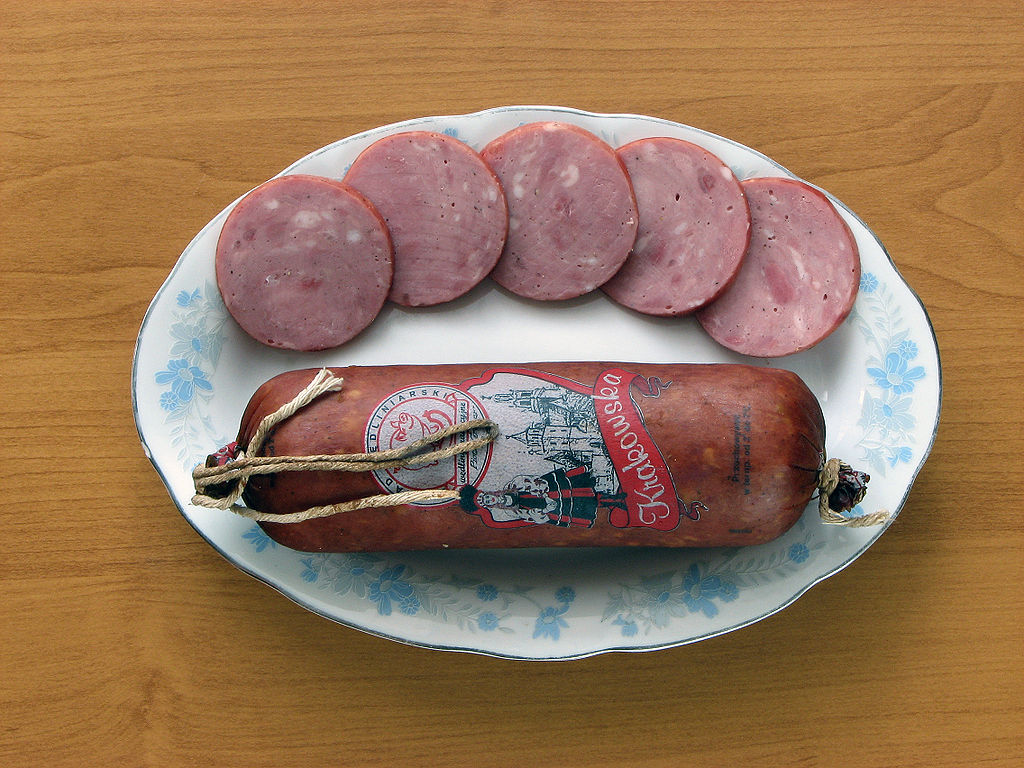
Kiełbasa Krakowska Sucha
Probably the most famous of the three Krakowian Kiełbasa, as evidenced by the garnering of the most obvious name, Kiełbasa Krakowska is sandwich staple across the country. Unlike the other sausages in our list, this one is generally sliced and served salami style as a cold cut, rather than served whole and hot off the fire. Also known as the German Krakauer, it differs in shape from the other sausages: drier, shorter, thicker and straighter. It is a smoked sausage whose main ingredients involve a combination of high-quality pork meats, beef or mutton, nutmeg, coriander seeds, paprika, garlic, salt, pepper and potato starch. The meat is prepared by some serious chopping and mixing preceding and throughout 2 days of curing in the refrigerator. Once it’s all become “a homogenous mass’ (mm.. yummy), the mix is piped into sausage casing made from either intestines or protein. It’s sectioned off with burning yarn and then hot-smoked for at least an hour before being dunked in cold water and left hanging overnight in a cool place. You can also find Krakowska Parzona, which is a similar but boiled version.
The tradition of this kiełbasa goes back to the 19th century when production first began in Krakow, which was at this time situated not in Poland but the partitioned Kingdom of Galicia. The Galician butchers were famous right across Europe for centuries and the Krakow sausage was the jewel in its crown, gaining particular popularity, which it maintains to this day, in Austria, Lithuania and Germany. Invented by ‘butcher's master’ Wincenty Satalecki who lived right here in the city and died in 1914, Kiełbasa Krakowska was inspired by his heritage of butcher tradition, passed down from his ancestor Jan. Wincenty originally made & sold the sausage in ul. Floriańska - his shop & workshop in the Old Town named "Kamienica Sataleckich" (Satalecki Tenement House) - recognisable by the sculpted architectural detail of “Okiem Opatrzności i dwoma baranami” (Eye of Providence and two sheep) which still decorates the facade today. From the late nineteenth to the early twentieth century, Kiełbasa Krakowska was also produced by a guy named Józef Bialik.
In 2018 ‘Kiełbasa Krakowska Sucha Staropolska’ (Old Polish Style Dry Krakow Sausage) was given ‘Regional and Traditional Product Protection’. In Austria, Kiełbasa Krakowska is also on the official list of traditional food products, after being entered in the ‘Register der Traditionellen Lebensmittel’.
Interesting fact:
-
During the Soviet occupation, there was a casino in Lviv called ‘Nobleman's Casino’ which was popular for its good dinners. The meal available to you, however, was based on your rank and merit. Further elucidating the legendary status of Kiełbasa Krakowska, only members of ‘The Academy’ were allowed the privilege of eating our debonaire sausage.
Where to find it?
These days it’s very common and can be bought in just about every supermarket. However, the best reputations when it comes to Krakowska Sucha belong to:
- Krakowski Kredens - Specializing in traditional Galician products can be bought not only in their Old Town flagship store but also many other locations across Krakow and Poland.
- Bacowka - Specializing in traditional Highlander and regional products, this store also has a range of locations including Kazimierz, in which you can purchase their goods.
Photo: By Mariuszjbie - Praca własna, CC BY-SA 3.0,
.jpeg?1564054247220)
Sledz
This salty little fish might hail from the Baltic Sea but it’s had no trouble swimming all the way downstream to Krakow where it’s still busy making waves. Herring has been a part of European cuisine since time immemorial, and it’s always had a lot to recommend it: easy to obtain in high quantities, easy to preserve, cheap to buy, healthy for the body and a pleasure to consume. Unlike all the sausages on this list, Sledz also has the benefit of being an appropriate meal during times of fasting, such as Lent, for both Jews and Catholics. In this way, like carp, it has also found itself a traditional place on the table at Christmas. For these same reasons, herring (although the first mention of it in Polish history was way back in the 12th century) enjoyed rather a renaissance throughout the sparse decades of PRL communist regime in Poland. With little money or resources to go around, this cheap, cheerful and long-lasting fish was an absolute staple on the Polish menu, and certainly in the Krakowian kitchen.
The most famed flavour among the herring clan belongs to the Dutch ‘Matjas’ which are, rather bizarrely, young and specifically virginal fish. Apparently, their taste is most delicious when caught preceding their first birthday, before they have had the opportunity to join the annual breeding orgy. Matias is usually eaten sandwich style, in a bun or on top of a slice of bread. In general, sandwiches are a popular way to consume herring, however, in Krakow you will find that there are many different ideas of how to serve this succulent and scaly snack.
With a long tradition as an accompaniment to vodka aka Zakąski Przekąski or ‘Polish Tapas’, herring is one of many pickled items used to steady the soul for an evening of drunken banter. In this situation, Sledz will usually be served straight up on its own yet marinated in any number of styles from the two most classic: rapeseed oil and onion, or, with cream; to more modern exotic marinations such as hot chilli, mango or Thai. A popular way to plate this up is to serve it as ‘Polish Sushi’ in rollmop form. There's one more serving style we would be remiss to mention: beloved around a campfire in the summer or perhaps beside the fireplace during winter - herring with baked potato is a wonderful dish.
Where to find it?
- Buy it in-store: You can find regular herring in every supermarket with jars, tins and in plastic containers of this beloved fish lining the fridge section of even the smallest stores. You can also find it fresh in the delicatessen.
- When we get the craving for this delicate pink fish, we buy our holy virginal Matjas from Naturalny Sklepik on ul. Krupnicza just off the Old Town.
- Eat out in Krakow's Old Town: Herring is so popular in Krakow, it even has it’s own embassy right across from the American and German Consulates in the Old Town. This is not a joke. Ambassadia Sledzia proudly serves up more kinds of herring than you can probably handle and is the perfect place to explore this locally beloved dish with some vodka to boot. Across the street is heavily herringly decorated sister 'Śledź u Fryzjera' which is equally worth a visit, if just to admire their dedication to painting herrings.
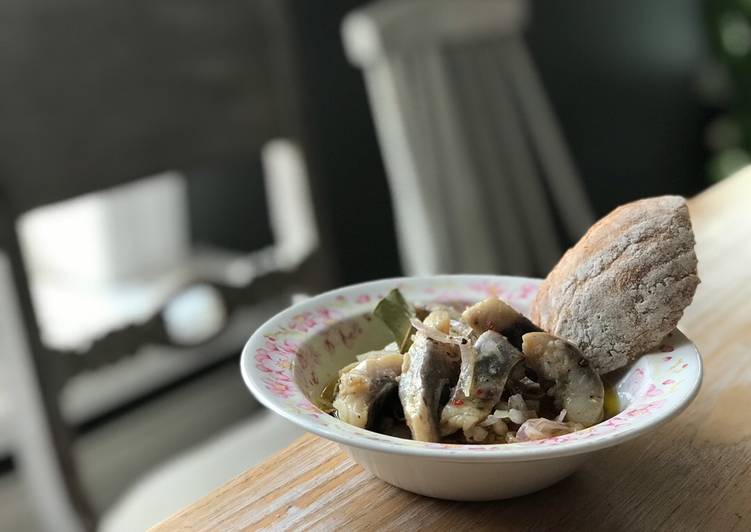
Marta's Recipe for Herring Marinated In Linseed Oil And Lemon
“The first time I ate this dish, it was at Hotel Francuski’s Gessler Restaurant in Krakow. The herring was served with a hot potato. Although this restaurant has long gone, the has taste remained and is still passed on to guests at our table. I like herring in every form, for instance, fried fresh in a pan and later marinated in vinegar.”
Ingredients
1.5-litre jar
300 grams of herring
200 ml of linseed oil
2 large lemons
5 kernels of Allspice
3 carnations
2 bay leaves
5 black pepper grains
1 litre of cold water with ice
1 glass of apple cider vinegar
Preparation
1. Soak the herring for a few hours in iced water, changing the water at least once. Strain water.
2. Chop onion into 'feathers' and pour vinegar. Strain after a few minutes, dry and put in the fridge.
3. Wash the lemons and cut them into slices.
4. Layer your onions, spices, lemons and herring into a large jar, when it’s all stacked inside, fill the jar up with linseed oil until all ingredients are beneath the surface of the oil.
5. Seal with lid and leave it to marinate for at least a few days.
For the fullest experience and loads more brilliant stories to go with every bite, we can't emphasise enough how much we recommend joining a dinner or workshop with Krakowian kitchen queen and founder of food sharing community Eataway, local legend Marta Bradshaw. You will honestly have the best time ever.
Hungry for more? Stay tuned for part 4 of Krakow Kitchen: Regional Desserts... coming soon.
In the meantime, you can check out another delicious article.
- The 9 Best Breakfasts in Krakow
- The 6 Best Coffee Spots in Krakow
- The 5 Best Indian Restaurants in Krakow
- Krakow's Freshest New Cafes, Bars & Restaurants
Did we miss something tasty? Let us know in the comments below!
